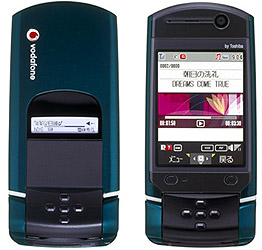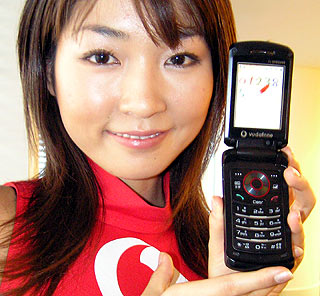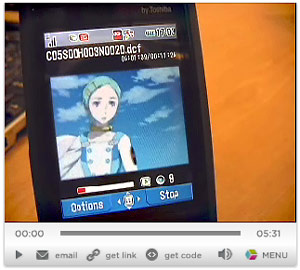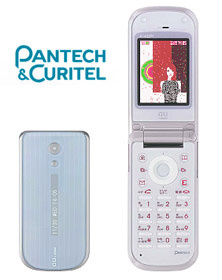Vodafone Japan New 3G Phones: Details, Audio Interview
Last week was a rare clean sweep in Japan’s tooth-and-nail handset race as each of the Big Three carriers in turn announced multiple new 3G models at splashy press events. Across the field, we saw an onboard 4-GB hard drive and a digiTV phone from KDDI, the 702i ‘designer’ models from DoCoMo and Japan’s first Samsung phone and new 3G data services from Vodafone. 
It’s no simple coincidence that this week the carriers are announcing their third-quarter financial results: it’s super vital to have a flashy new set of handsets to point to when presenting your report card to the analysts in Tokyo and London. Also, spring is the premiere mobile sales season in Japan and the models announced last week should hit the streets around cheery blossom time.
If Vodafone Japan’s market troubles in the past couple of years can be blamed on handset mix, then the new phones may go a long way to to fixing Big Red’s market position. Today’s WWJ Portable Reportable MP3 audio report features an interview with Vodafone Japan from last week’s press event with in-depth details on their new 3G models, which include phones from Samsung, Toshiba, Sharp and NEC, and comments on competitive positioning in the market.


 At a Tokyo press conference today, Vodafone Japan announced four new 3G terminals including a model provided by Korean maker Samsung. This is the first Samsung model to become available in Japan. The Vodafone V804SS (image at right) is said to be the world’s thinnest 3G handset and features a 2.3-in QVGA main LCD display, 2 cameras, stereo twin speakers, music features and the “Deru Moji” 3D Pictogram Display. The other handsets include models from Sharp (V804SH), NEC (V804N) and Toshiba (V904T).
At a Tokyo press conference today, Vodafone Japan announced four new 3G terminals including a model provided by Korean maker Samsung. This is the first Samsung model to become available in Japan. The Vodafone V804SS (image at right) is said to be the world’s thinnest 3G handset and features a 2.3-in QVGA main LCD display, 2 cameras, stereo twin speakers, music features and the “Deru Moji” 3D Pictogram Display. The other handsets include models from Sharp (V804SH), NEC (V804N) and Toshiba (V904T). It’s rare for WWJ editors, a jaded bunch, to get too excited about new service announcements, but on 6 December, we jumped on this fresh Vodafone
It’s rare for WWJ editors, a jaded bunch, to get too excited about new service announcements, but on 6 December, we jumped on this fresh Vodafone 
 Back in 1999, when I was editing Computing Japan magazine, we ran an article entitled “
Back in 1999, when I was editing Computing Japan magazine, we ran an article entitled “